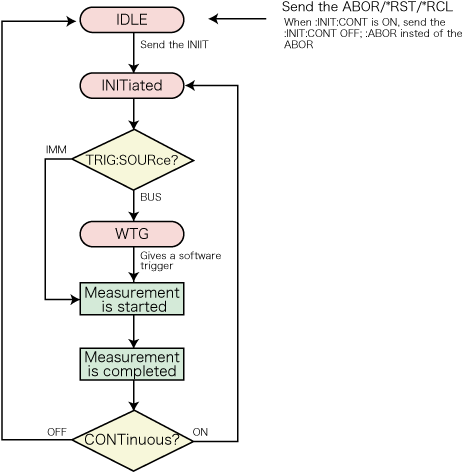Tutorial
Measurement
The simplest measurement procedure
The KPM1000 has features for returning the measured voltage, current, and power. The simplest measurement procedure is simply to send the MEASure? query. When you send the MEAS? query, some of the measurement conditions are set to the default values, and this enables you to retrieve the measured data with the minimum amount of trouble.
Because the MEASure? query sets some of the measurement conditions to the default values, you cannot use this query to measure the integrated current, integrated voltage, or integration time. If you send the MEASure? query while the KPM1000 is performing integration, an error (-221, Settings conflict) will occur.
The MEASure query sets some of the KPM1000 measurement conditions to the default values, and then starts a new measurement. Because this query starts a new measurement each time that it is sent, you cannot use it to synchronize the measurement of multiple items.
You can use the MEAS? query to perform measurements even if you do not possess in-depth knowledge of measuring instruments. On the other hand, because this query sets some of the measurement conditions to default values, you cannot use this query to set detailed measurement conditions. If you want to perform measurements with more detailed conditions, configure the settings, and then send the READ? query. The MEAS? query performs the same operations as the following sequence: *RST, SENS:CURR:RANG:AUTO OFF, and then the SENS:VOLT:RANG:AUTO OFF command followed by the READ? query.
Measuring voltage and current
MEASure:VOLTage:AC? 'Query the voltage.
MEASure:CURRent:AC? 'Query the current.
A slightly more flexible measurement procedure
When you use the READ? query to perform measurements, the process is broken up into two steps: (1) setting the measurement conditions and (2) starting the measurement and retrieving data.
You can set the measurement conditions, and then use the READ? query to start the measurement.
SENS:CURR:RANG:AUTO ON 'Turn on the current auto range.
SENS:FILT ON 'Turn on the low pass filter.
READ:CURR:CRES? 'Query the current crest factor.
(Reading the response)
FETC:VOLT:AC?;CRES?;AMPL:MAX? 'Query the voltage.
(Reading the response)
If you want to abort the measurement that you have started, send the ABORt command. You can also use this to abort *RST commands and IEEE488.1 sdc/dc. You cannot use the *CLS command to abort the measurement. After the measurement starts, you cannot change any measurement conditions or trigger settings. You can only change these settings after the measurement finishes or is aborted. Using the READ? query to perform measurements is a flexible method because it enables you to specify detailed measurement conditions. The READ? query starts a new measurement each time that it is sent, so this method is not flexible in terms of measurement timing. If you want to program detailed measurement timing, use the INIT command and the FETC? query to separate the start of the measurement from the retrieval of data. The READ? query performs the same operations as the following sequence: the INIT command followed by the FETC? query.
The most flexible measurement procedure (advanced measurement)
Using the INIT command and the FETC? query to perform advanced measurement separates the start of the measurement from the retrieval of data. This provides you with the most detailed control over measurement. The INIT command instructs the KPM1000 to start the measurement. FETC? queries the completed measurement data. If you want to use software triggers to manage the timing of the start of measurement, you have to use the INIT command and the FETC? query.
Status
A sequence has three states: IDLE, INITiated, and WTG. For details, click here.

Measuring voltage, current, or power
To start a new measurement, set the trigger source to IMMediate, and then use the INITiate command.
TRIGger:SOURce IMMediate 'Set the trigger source to IMM.
INITiate ' Initiate the measurement.
If you are using software triggers to start the measurement, change the trigger source to BUS.
TRIGger:SOURce BUS 'Set the trigger source to BUS.
INITiate ' Initiate the measurement.
TRIGger 'Apply a software trigger.
When the measurement finishes, you can use the FETCh query to retrieve the measured data.
FETCh:VOLTage:AC? 'Query the voltage.
FETCh:CURRent:AC? 'Query the current.
FETCh:POWer:AC:REAL? 'Query the active power.
FETCh:POWer:AC:APParent? 'Query the apparent power.
Use the TRIGger:SOURce command to set the trigger source to BUS or IMMediate. INITiate pulls the TRIGger subsystem out of the IDLE state and starts (initiates) the trigger feature.
If the trigger source is set to IMMediate, the measurement starts immediately. If the trigger source is set to BUS, the TRIGger subsystem enters the WTG (Waiting For Trigger) state. When a software trigger is received (through the TRIGger command or *TRG command), the measurement starts. When the measurement finishes, the TRIGger subsystem enters the IDLE state again. If the ABORt command or an equivalent command is received instead of a trigger, the measurement is canceled, and the TRIGger subsystem returns to the IDLE state.
The ABORt command and IEEE488.1 sdc/dcl abort measurements that are in progress. These commands do not invalidate measured data that has already been retrieved. On the other hand, the *RST command not only aborts a measurement that is in progress, but it also invalidates the retrieved measured data. If you send *RST;:FETC:VOLT:AC?, an error will occur because there is no measured data that the FETCh query can retrieve and there is no new measurement that is going to be performed.
The difference between the MEASure and READ commands and the FETCh command is as follows. The MEASure/READ command starts a new measurement and then queries the measured data. The FETCh command queries the measured data without first starting a new measurement.

